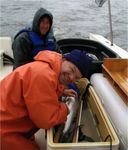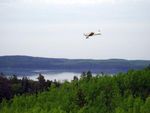New study tracks microplastics in Choptank watershed
←
→
Page content transcription
If your browser does not render page correctly, please read the page content below
JANUARY 2021
NEWS FROM THE UNIVERSITY OF MARYLAND CENTER FOR ENVIRONMENTAL SCIENCE
New study tracks microplastics in Choptank watershed
A two-year NOAA Marine Debris Program
funded project will track how microplastics
move through the Choptank River watershed on
the Eastern Shore of Maryland. Understanding
the fate and transport of microplastics will
provide a baseline of understanding what kind
of plastics exist in the waterway and how they
move through coastal systems.
“ A lot of attention is paid to the giant garbage
patch in the Pacific Ocean, but those plastics came from somewhere. We have to
understand where they are coming from and what happens to them before they get to
the ocean,” said Associate Professor Jamie Pierson. MORE
Fisheries expert Dave Secor reflects on career studying
sturgeon
Professor Dave Secor began his journey studying
the living fossils known as sturgeon when he
arrived at UMCES' Chesapeake Biological
Laboratory in 1993. He embarked on a scientific
mission to understand how these prehistory giants
disappeared from the Chesapeake Bay. Read
about how studying sturgeon has taught him more
than ever imagined in his reflections in "Atlantic
sturgeon: Not the 'ghosts' I thought they were" inthe Bay Journal. MORE Reducing mercury entering ecosystems quickly lowers mercury in fish we eat A study conducted over more than 15 years found that reducing mercury pollution entering lakes lowers how much harmful mercury is found in freshwater fish that end up for consumers’ plates. Fish populations were able to recover from mercury much quicker than previously understood, which suggests that curbing mercury pollution through policy initiatives will have a rapid and tangible benefit regarding the quality of fish we consume. MORE Photo by: Paul Blanchfield, Queens University Next Generation: Olivia Pares on disease in blue crabs
Graduate student Olivia Pares was raised understanding importance of conserving and
understanding the environment that allowed us to thrive. Her work at the Institute of
Marine and Environmental Technology leads to a greater understanding of the disease
ecology of viruses, specifically reovirus, in Maryland's favorite crustacean, the blue
crab.
"Research on the dynamics of these pathogens is vital because the reovirus causes
mortality to an economically and ecologically important species. In addition,
understanding the factors that influence the prevalence of the pathogen can help with
management and biosecurity strategies for the blue crab fishery," said Pares. MORE
John Piasecki wins UMCES Staff Excellence Award
Appalachian Laboratory Facilities
ManagerJohn Piasecki has been selected as
the 2021 recipient of the UMCES Staff
Excellence Award. The annual award
recognizes those staff members who
consistently demonstrate a high level of
commitment and dedication to UMCES.
“I’m honored to have been selected for this
year’s award,” said Piasecki. “We work as a
team at the Appalachian Laboratory, and I
truly appreciate being recognized as a
valued member of that team.” MOREUMCES IN THE NEWS
Unprecedented die-offs, melting ice: Climate change is wreaking havoc in the Arctic
and beyond (Los Angeles Times)
Climate change brings a perfect storm of raw sewage and rainfall in cities that can least
afford it (USA Today)
Five opportunities for sailors to knock down marine plastic pollution (Spinsheet)
Editorial: Making sense of bay grades (Yahoo News)
Here’s why blue crab has disappeared from menus around D.C. (Inside Hook)
Chesapeake Bay Hypoxia Report – Year-End 2021 (Southern Maryland Chronicle)
SHARE THE SCIENCE BEHIND THE NEWS
Sign up the Environmental Insights newsletter HERE.SUPPORT SCIENCE
Your tax-deductible gift will help us continue unbiased scientific research and the
education of the next generation of science leaders. DONATE
Appalachian Laboratory - Chesapeake Biological Laboratory
Horn Point Laboratory - Institute of Marine and Environmental Technology
Integration and Application Network - Maryland Sea Grant
AN INSTITUTION OF THE UNIVERSITY SYSTEM OF MARYLAND
University of Maryland Center for Environmental Science | umces.edu
You can also read


























































